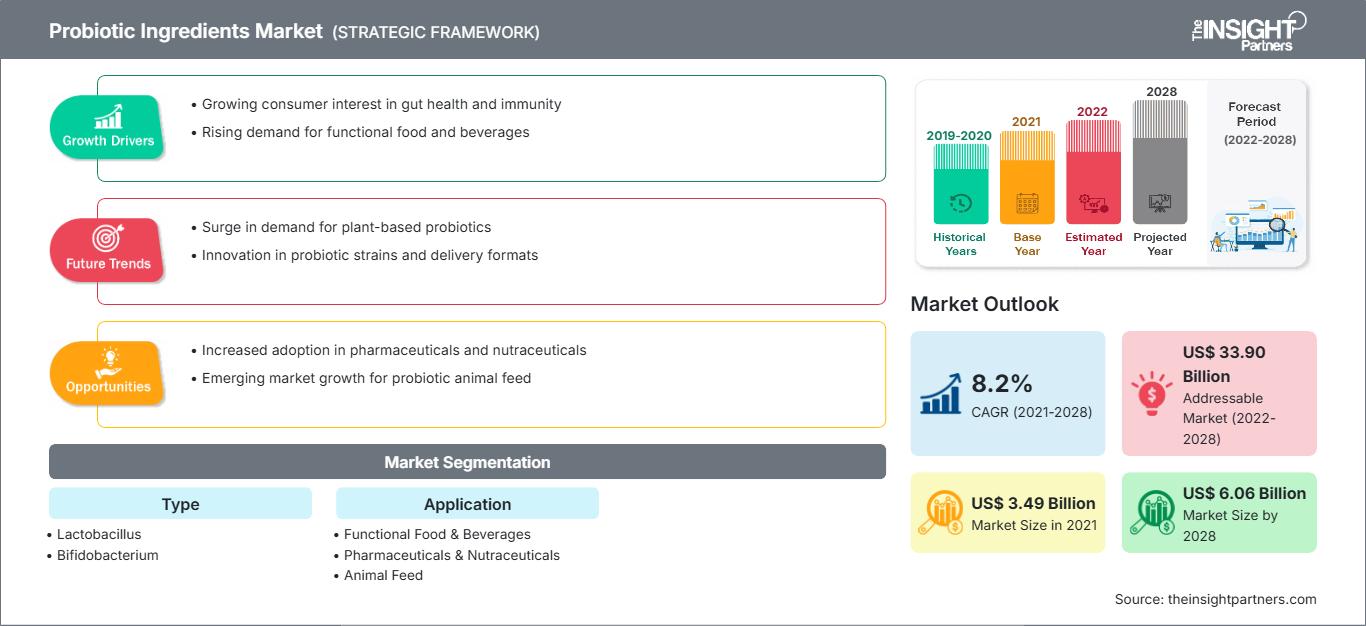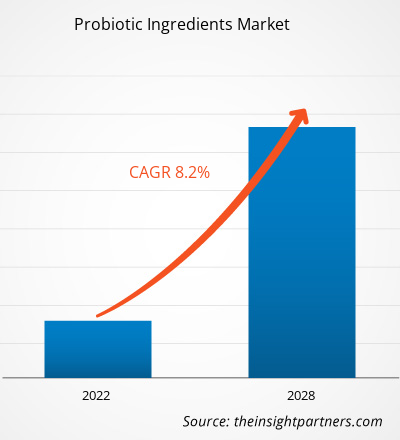Probiotic Ingredients Market Developments and Forecast by 2028
Historic Data: 2019-2020 | Base Year: 2021 | Forecast Period: 2022-2028Probiotic Ingredients Market Forecast to 2028 - COVID-19 Impact and Global Analysis By Type (Lactobacillus, Bifidobacterium, and Others) and Application (Functional Food & Beverages, Pharmaceuticals & Nutraceuticals, Animal Feed, and Others)
- Report Date : Jun 2022
- Report Code : TIPRE00005370
- Category : Food and Beverages
- Status : Published
- Available Report Formats :


- No. of Pages : 160
The probiotic ingredients market is expected to grow from US$ 3,493.42 million in 2021 to US$ 6,060.51 million by 2028; it is expected to grow at a CAGR of 8.2% from 2022 to 2028.
Probiotics are live microorganisms that provide health benefits when consumed, generally by improving or restoring the gut flora. Probiotics are considered generally safe to consume. Probiotics play a significant role in preventive healthcare as they prevent the occurrence of diseases by strengthening the immune system. Thus, rising awareness regarding preventive healthcare is expected to boost the market growth over the forecast period.
Asia Pacific held the largest probiotic ingredients market share in 2021, while other developing regions, such as the Middle East & Africa, are expected to grow significantly in the forecast period. The market growth is attributed to increasing demand for functional foods and beverages such as drinkable probiotic yogurt and plain yogurt and the growing influence of western culture on the young population in the region. Moreover, the manufacturers of probiotics are expanding their operations across Asia Pacific owing to the presence of a potential customer base, cheap labor, and adequate manufacturing facilities. Companies such as Probi and Bio-k+ (Kerry) operate actively in the region; this is projected to drive the Asia Pacific probiotic ingredients market over the coming years.
Customize This Report To Suit Your Requirement
You will get customization on any report - free of charge - including parts of this report, or country-level analysis, Excel Data pack, as well as avail great offers and discounts for start-ups & universities
Probiotic Ingredients Market: Strategic Insights

-
Get Top Key Market Trends of this report.This FREE sample will include data analysis, ranging from market trends to estimates and forecasts.
Impact of COVID-19 Pandemic on Probiotic Ingredients Market
The COVID-19 pandemic brought unprecedented challenges for many sectors in early 2020. Lockdowns, border restrictions, travel bans, manufacturing discontinuation, and other safety measures rolled out by governments as per the guidelines of the WHO and national health ministries hampered the manufacturing operations. However, the COVID-19 outbreak positively impacted the market as consumers are increasingly seeking natural and safer alternatives to keep themselves healthy and strengthen their immune systems. The demand for dietary supplements increased dramatically during the initial months of the pandemic. Moreover, as people stayed at home due to the government mandates, they focused on their health and fitness, which stimulated the demand for probiotics during the pandemic.
Market Insights
Rising Demand for Probiotic-Fortified Food and Beverages
Consumers are becoming more health-conscious and paying more attention to their lifestyles and diets, resulting in a boom in demand for probiotic-fortified foods and beverages worldwide. To suit consumer demand, food manufacturers are developing various new products with instructions and pictures in response to the current healthy eating trend. For instance, Yakult Honsha, a Japanese company, launched a probiotic dairy drink in 1955, which was dismissed by several industry experts; however, currently, it’s the world’s largest probiotic dairy brand found in Asia Pacific, Europe, and North Americas, which is driving the growth of market.
Type-Based Insights
Based on type, the probiotic ingredients market is segmented into Lactobacillus, Bifidobacterium, and Others. The Lactobacillus segment is projected to register the largest share during the forecast period. It is considered one of the safest bacteria to be used as probiotics. Lactobacillus is a type of bacteria that primarily finds application in fermented foods such as kefir, sauerkraut, and yogurt. Lactobacillus strains are helpful to people because they can reduce human intestinal disorders, which is expected to boost its demand. The growth of the lactobacillus segment is driven by the rising application of probiotics in food, especially dairy products, fueling the growth of the market.
Application-Based Insights
Based on application, the probiotic ingredients market is segmented into functional food & beverages, pharmaceuticals & nutraceuticals, animal feed, and others. The pharmaceuticals & nutraceuticals segment is projected to register the highest CAGR in the market during the forecast period. The rising demand for preventive medicines, a growing number of digestive ailments among the elderly, and the lack of a balanced diet are likely to increase product demand in the dietary supplement industry. Consumers increasingly prefer probiotic-based food supplements owing to the growing adoption of unhealthy diets.
The key players operating in the probiotic ingredients market are ADM; Novozymes A/S; Chr. Hansen Holding A/S; Kerry; Lallemand Inc.; IFF Nutrition & Biosciences; AngelYeast Co., Ltd.; Probiotical S.p.A.; Adisseo; and Probi. These players are engaged in developing products with reduced health risks to meet emerging consumer trends and abide by regulatory frameworks. They are involved in mergers and acquisitions, business expansions, and partnerships to expand their market share.
Probiotic Ingredients Market Regional InsightsThe regional trends and factors influencing the Probiotic Ingredients Market throughout the forecast period have been thoroughly explained by the analysts at The Insight Partners. This section also discusses Probiotic Ingredients Market segments and geography across North America, Europe, Asia Pacific, Middle East and Africa, and South and Central America.
Probiotic Ingredients Market Report Scope
| Report Attribute | Details |
|---|---|
| Market size in 2021 | US$ 3.49 Billion |
| Market Size by 2028 | US$ 6.06 Billion |
| Global CAGR (2021 - 2028) | 8.2% |
| Historical Data | 2019-2020 |
| Forecast period | 2022-2028 |
| Segments Covered |
By Type
|
| Regions and Countries Covered |
North America
|
| Market leaders and key company profiles |
|
Probiotic Ingredients Market Players Density: Understanding Its Impact on Business Dynamics
The Probiotic Ingredients Market is growing rapidly, driven by increasing end-user demand due to factors such as evolving consumer preferences, technological advancements, and greater awareness of the product's benefits. As demand rises, businesses are expanding their offerings, innovating to meet consumer needs, and capitalizing on emerging trends, which further fuels market growth.

- Get the Probiotic Ingredients Market top key players overview
Report Spotlights
- Progressive industry trends in the probiotic ingredients market to help players develop effective long-term strategies
- Business growth strategies adopted to secure growth in developed and developing markets
- Quantitative analysis of the probiotic ingredients market from 2022 to 2028
- Estimation of global demand for probiotics
- Porter's Five Forces analysis to illustrate the efficacy of buyers and suppliers operating in the industry
- Recent developments to understand the competitive market scenario
- Market trends and outlook, and factors governing the growth of the probiotic ingredients market
- Assistance in the decision-making process by highlighting market strategies that underpin commercial interest, leading to the market growth
- Size of the probiotic ingredients market at various nodes
- Detailed overview and segmentation of the market and the probiotics industry dynamics
- Size of the growth in various regions with promising growth opportunities
Frequently Asked Questions
What are the key drivers for the growth of the global probiotic ingredients market?
Based on the application, which segment is projected to grow at the fastest CAGR over the forecast period?
Can you list some of the major players operating in the global probiotic ingredients market?
What are the opportunities for probiotic ingredients in the global market?
Based on the type, why is the Lactobacillus segment have the largest revenue share?
What is the largest region of the global probiotic ingredients market?
Habi is a seasoned Market Research Analyst with 8 years of experience specializing in the Chemicals and Materials sector, with additional expertise in the Food & Beverages and Consumer Goods industries. He is a Chemical Engineer from Vishwakarma Institute of Technology (VIT) and has developed deep domain knowledge across industrial and specialty chemicals, paints and coatings, paper and packaging, lubricants, and consumer products. Habi’s core competencies include market sizing and forecasting, competitive benchmarking, trend analysis, client engagement, report writing, and team coordination—making him adept at delivering actionable insights and supporting strategic decision-making.
- Historical Analysis (2 Years), Base Year, Forecast (7 Years) with CAGR
- PEST and SWOT Analysis
- Market Size Value / Volume - Global, Regional, Country
- Industry and Competitive Landscape
- Excel Dataset
Related Reports
Testimonials
The Insight Partners' SCADA System Market report is comprehensive, with valuable insights on current trends and future forecasts. The team was highly professional, responsive, and supportive throughout. We are very satisfied and highly recommend their services.
RAN KEDEM Partner, Reali Technologies LTDsI requested a report on a very specific software market and the team produced the report in a few days. The information was very relevant and well presented. I then requested some changes and additions to the report. The team was again very responsive and I got the final report in less than a week.
JEAN-HERVE JENN Chairman, Future AnalyticaWe worked with The Insight Partners for an important market study and forecast. They gave us clear insights into opportunities and risks, which helped shape our plans. Their research was easy to use and based on solid data. It helped us make smart, confident decisions. We highly recommend them.
PIYUSH NAGPAL Sr. Vice President, High Beam GlobalThe Insight Partners delivered insightful, well-structured market research with strong domain expertise. Their team was professional and responsive throughout. The user-friendly website made accessing industry reports seamless. We highly recommend them for reliable, high-quality research services
YUKIHIKO ADACHI CEO, Deep Blue, LLC.This is the first time I have purchased a market report from The Insight Partners.While I was unsure at first, I visited their web site and felt more comfortable to take the risk and purchase a market report.I am completely satisfied with the quality of the report and customer service. I had several questions and comments with the initial report, but after a couple of dialogs over email with their analyst I believe I have a report that I can use as input to our strategic planning process.Thank you so much for taking the extra time and making this a positive experience.I will definitely recommend your service to others and you will be my first call when we need further market data.
JOHN SUZUKI President and Chief Executive Officer, Board Director, BK TechnologiesI wish to appreciate your support and the professionalism you displayed in the course of attending to my request for information regarding to infectious disease IVD market in Nigeria. I appreciate your patience, your guidance, and the fact that you were willing to offer a discount, which eventually made it possible for us to close a deal. I look forward to engaging The Insight Partners in the future, all thanks to the impression you have created in me as a result of this first encounter.
DR CHIJIOKE ONYIA MANAGING DIRECTOR, PineCrest Healthcare Ltd.Reason to Buy
- Informed Decision-Making
- Understanding Market Dynamics
- Competitive Analysis
- Identifying Emerging Markets
- Customer Insights
- Market Forecasts
- Risk Mitigation
- Boosting Operational Efficiency
- Strategic Planning
- Investment Justification
- Tracking Industry Innovations
- Aligning with Regulatory Trends




















 Get Free Sample For
Get Free Sample For